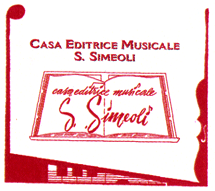
Codice: MA607 |
|
|
|
Due mandolini
Munier Carlo
Duetti per due mandolini (10) parte terza fino alla terza posizione
Collana di musica per mandolino e strumenti a plettro a cura di Maria Cleofe Miotti e Vittorio Naldi
Edizioni:Curci
Utile dulci
Utile dulci è il nome della raccolta di trascrizioni di duetti in diverse posizioni che Munier propone ai mandolinisti. L’intento didattico coniuga l’esigenza dell’allievo di eseguire musica d’insieme e contemporaneamente, di venire a conoscenza di composizioni di celebri autori del panorama musicale internazionale. Nello specifico, la Parte III op. 220 comprende dieci duetti per due mandolini (fino alla terza posizione) in diverse tonalità con un massimo di tre alterazioni in chiave.
Queste trascrizioni si caratterizzano per una scrittura attenta e precisa dal punto di vista tecnico ed espressivo. La maggiore articolazione di posizioni riguarda il primo mandolino, a cui spetta la parte melodica, che si muove in tessiture più acute; l’uso del 4° dito è abbastanza frequente per consentire la successione alternata delle pennate nell’ambito della medesima corda, o per conservare la legatura di suono, anche nell’esecuzione di particolari abbellimenti. La cura del fraseggio, evidenziata dai segni di legatura dell’inciso o della frase, dai mutamenti agogici, dinamici e dalle indicazioni di espressione, prevede l’alternanza di passaggi da eseguire con la tecnica del tremolo con altri in cui le note sono solo pizzicate, soprattutto nei tempi più veloci o dove è richiesta maggiore agilità.
La parte del secondo mandolino, che ha un ruolo di accompagnamento e di controcanto alla prima voce, è caratterizzata spesso da una scrittura arpeggiata che sottolinea e sostiene l’andamento ritmico: in alcuni duetti si trovano note doppie, da eseguirsi sia tremolate sia staccate. Nell’edizione Maurri non compare alcuna indicazione delle pennate.
Allo stesso modo, nella presente edizione si è mantenuto questo criterio poiché questi duetti si rivolgono a un esecutore che abbia già una buona conoscenza di base e pratica dello strumento. Sono state conservate in massima parte le diteggiature originali, con qualche aggiunta o variazione laddove ritenuto necessario per una migliore articolazione delle dita, o per rendere con maggiore espressività sonora il carattere della frase.
Utile dulci is the name given to the collection of transcriptions of duets by Munier with the mandolin in various positions. The teaching purpose covers both the need of the student to perform ensemble music and at the same time to get to know compositions by famous composers on the international music scene. More specifically Parte III op. 220 comprises ten duets for two mandolins (up to the third position) in various keys with a maximum of three key changes.
The writing of these transcriptions is careful and accurate from the technical and expressive standpoints. The greater detailing of positions concerns the first mandolin which is given the melodic part and which moves in higher ranges. The use of the fourth finger is fairly frequent to allow the alternating sequence of strums as part of the same chord or to maintain ligature, also in the performance of particular embellishments. The work on the phrasing, demonstrated by the tie signs of the motif or phrase, by the changes in agogics and dynamics and the indications of expression, involves the alternating of parts to be performed with the tremolo technique with others in which the notes are only pizzicato, particularly at the faster tempos and where greater agility is required. The part of the second mandolin, which has a role of accompaniment and counter-melody to the first melody, often features arpeggios which underline and support the rhythmic progression: some duets have double notes, to be played both in tremolo and staccato style. In the Maurri edition there is no indication of strumming. This edition likewise maintains this condition as these duets are intended for musicians with already a good basic and practical knowledge of the instrument. The original fingering has mostly been retained, with a few additions or variations where considered necessary for better articulation of the fingers or for rendering the nature of the phrase with greater musical expressiveness.
„Utile dulci” ist der Titel einer Sammlung von Duett-Transkriptionen in verschiedenen Positionen, die Munier für Mandolinisten geschaffen hat. Lehrabsicht ist es, das für die Schüler notwendige Zusammenspiel und die gleichzeitige Auseinandersetzung mit Werken berühmter Komponisten der internationalen Musikszene zu verbinden. Insbesondere Teil III von Op. 220 enthält 10 Duette für zwei Mandolinen (bis zur dritten Position) in verschiedenen Tonarten, jedoch mit höchstens drei Vorzeichen. Muniers 10 Transkriptionen zeichnen sich durch Sorgfalt und Präzision aus, sowohl was die Technik als auch die Musikalität angeht. Die Mehrzahl der Lagenwechsel erfolgt in der 1. Mandolinenstimme, welcher der melodische Teil obliegt und die sich in höheren Tonlagen bewegt. Die Verwendung des vierten Fingers kommt häufig vor, um die abwechselnde Reihenfolge der Federschläge auf der selben Saite oder Bindungen zu ermöglichen, ebenso bei der Ausführung von besonderen Verzierungen.
Die sorgfältige Ausarbeitung der Phrasierung, welche durch Phrasierungsbögen, Änderungen der Agogik, der Dynamik und durch Ausdrucksbezeichnungen kenntlich wird, sieht auch einen Wechsel von Passagen in Tremolo-Technik mit anderen Passagen vor, in denen die Saiten nur gezupft werden, insbesondere bei raschen Tempi oder dort, wo große Geläufigkeit verlangt wird. Der zweiten Mandoline fällt die Rolle der Begleitung und der Gegenmelodie zur ersten Mandoline zu. Sie ist oft durch Arpeggiosätze gekennzeichnet, die den Rhythmus unterstützen oder vorgeben. In einigen Duetten findet man Doppelgriffe, die in Tremolo-Technik oder als Staccato durchgeführt werden müssen. Bei der Ausgabe von Maurri sind die Schläge nicht angegeben und in dieser Ausgabe hat man dieselben Richtlinien befolgt, da diese Duette voraussetzen, dass der Musiker über eine gute Grundlage und Übung auf dem Instrument verfügt. Es wurden meist die ursprünglichen Fingersätze beibehalten und nur wenige Ergänzungen oder Änderungen eingefügt, die für eine bessere Beweglichkeit der Finger oder zugunsten eines ausdruckstärkeren Klanges für notwendig erachtet wurden.
紹介その1
Utile dulciは、ムニエルが様々なポジションを用いてマンドリニスト達に提案した、二重奏の編曲集である。学習する者が、合奏を楽しみつつ国際的に有名な作曲家作品に接する機会を得る、という教育的意図を兼ね備えている。ParteIII Op.220は最高で3つの#、bを含む調のマンドリンデュエット10曲からなる(第3ポジションまで)。ムニエルによる10の編曲は、技術面でも音楽面でも、とても注意深く正確に書かれている。高音域を使ってメロディーを担当するファーストマンドリンのポジション移動は、弦を替えずに同じ弦上をピックが上下し、なおかつ音をきれいにレガートさせ、更に装飾音を支障なく演奏するために、4の指(小指)の使用が頻繁である。フレージングは、表現指示、強弱記号、休符を伴った小旋律と小楽節をスラーで明示。トレモロで奏するパッセージと、速いテンポで軽快さの求められる箇所ではピッキングで奏することもあらかじめ考慮されている。セカンドマンドリンは伴奏、又は、主旋律に対する対偶主題で、しばしばアルペッジョが印され、テンポの維持を任されている。又、二重音がトレモロ、スタッカートで用いられているデュエットもいくつかある。マウリ社版ではピックの上下に関する指示はない。今回の版に関しても、この曲を弾く奏者にはマンドリンに関する基本的知識があることを前提にして指示はつけなかった。大部分の指使いはオリジナルに示されたものそのままを使用。演奏をより明瞭にし、かつ、フレーズの持ち味を生かすために必要と思われる箇所には付加、変化を施した。 日本語訳 西山みき
Disponibilità:

Prezzo: € 15,00
 |



